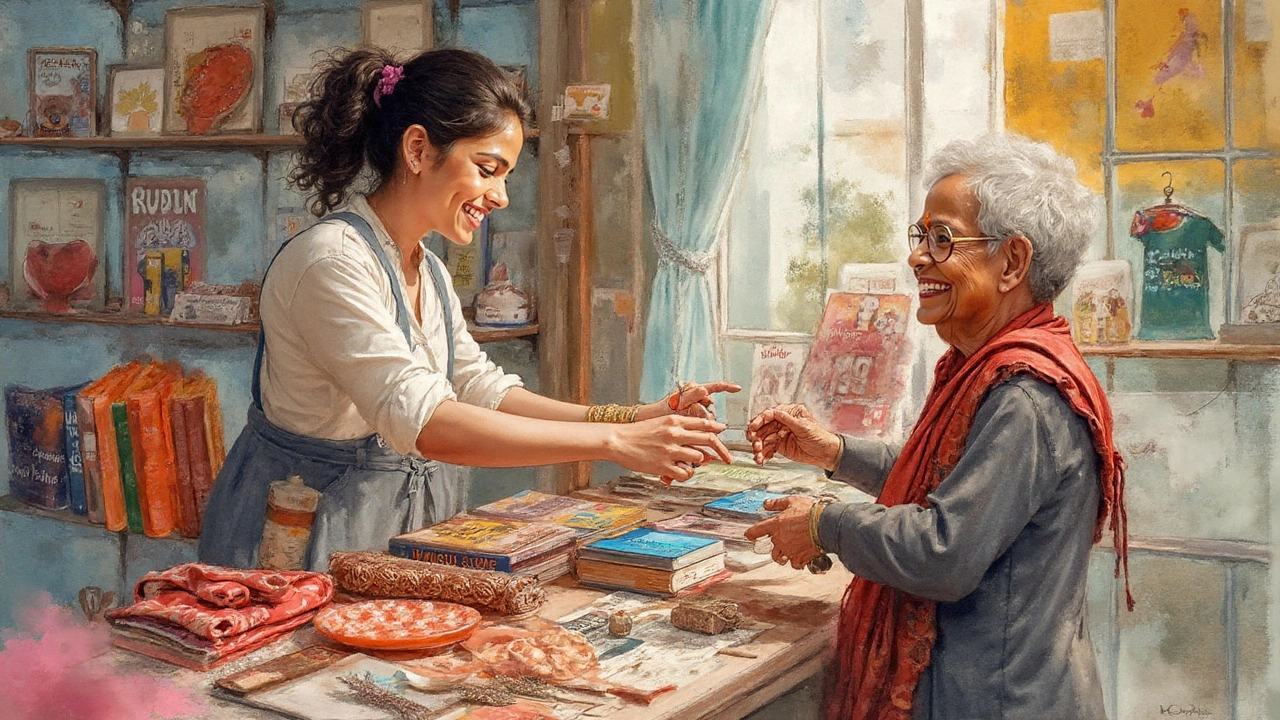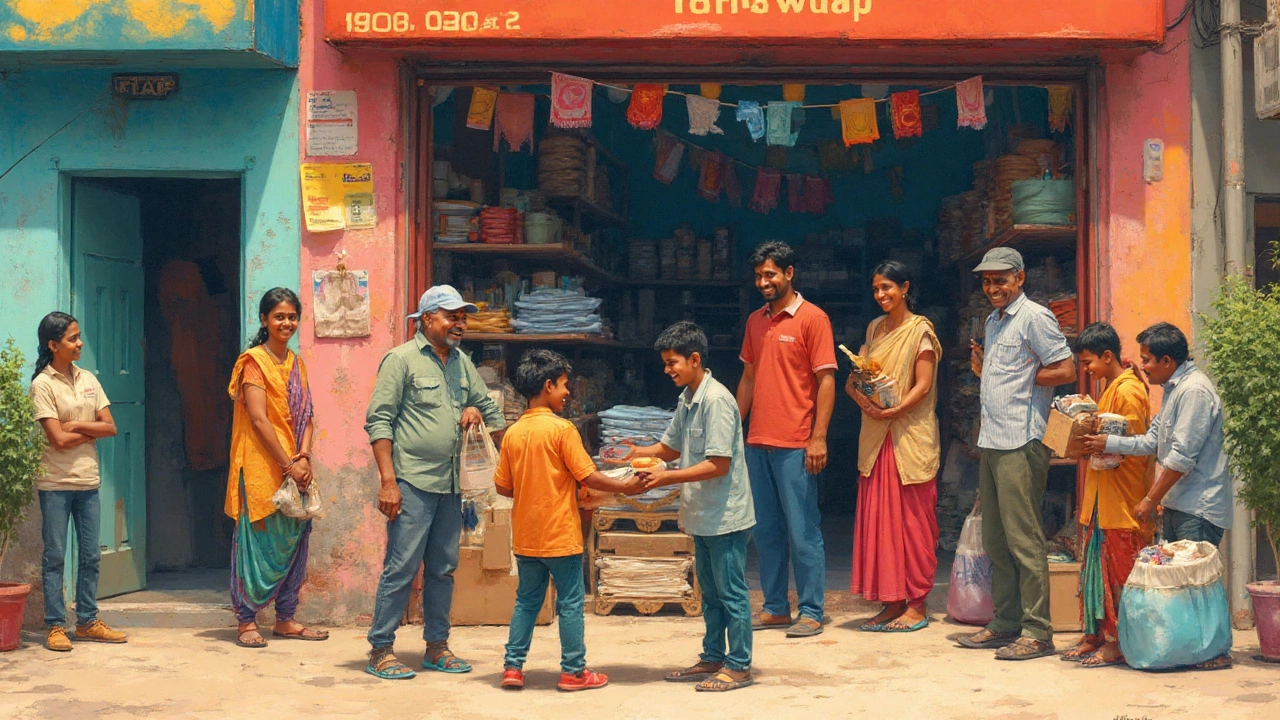Volunteering in a Charity Shop: Benefits, Skills, and Real-Life Impact
 Aug, 6 2025
Aug, 6 2025
Ever walked past a charity shop and wondered if spending a few hours inside folding shirts or sorting donations actually matters? Or maybe someone told you it looks good on a CV, but you can’t shake the idea it’s just about tidying shelves. The reality is, there’s a whole other world inside those four walls—one that’s busy, unpredictable, and sometimes even a little mad (in the best way possible). Plenty of folks in the UK turn to charity shops for clothes, books, even vintage treasures, and the volunteer army behind the scenes keeps everything humming. So, what really goes on when you volunteer? And does it live up to the hype?
The Everyday Reality of Working in a Charity Shop
First off, forget the idea of this being a slow, sleepy job. Once you step behind that counter, you’re pulled into a tornado of customers, donations, quirky co-workers, and surprises in every box you open. Mornings usually start with a stack of bags dropped off overnight. You might find brand new jeans with the tags still on next to a jumble of china mugs or, if you’re really lucky (or unlucky), a pile of ‘mystery’ items that might take a brave soul to investigate.
Your first big lesson volunteering in a charity shop is how much trust strangers have in you. People donate stuff with emotional value—someone’s teddy from childhood, a wedding dress, those books with scribbled dedications. Sorting means handling things delicately, deciding what gets a second life on the shop floor. You learn to spot a gem from junk fast. There’s a practical skill in learning if that coat is cashmere or a dodgy polyester blend.
Staff and other volunteers shape the shop’s energy. Some are retired ex-bankers, others are college students, a few are folks with learning difficulties or people rebuilding their lives after tough times. Turns out, the team feels more like a makeshift family than a crew of colleagues. Break times aren’t just a sandwich and a cuppa—they’re about sharing stories and advice you never thought you’d ask for. Need help with English homework? There’s usually someone who’ll volunteer a grammar tip right there next to the kettle.
Even if your main gig is manning the till, every customer means a new story. Someone’s hunting for a rare vinyl to complete a collection; another is buying clothes for a job interview, crossing their fingers for a fresh start. Elderly regulars come in, not just for a bargain but for a chat—they might not talk to anyone else all week. These daily connections are what keep the place alive.
It’s not all heartwarming. Some donations turn out to be trash bags of broken or unusable stuff, which means learning the art of polite refusal. Busy days sometimes mean sorting in the freezing stockroom next to a heater barely strong enough to thaw your fingers. It can get stressful when the queue’s out the door or a card machine decides to throw a tantrum. Still, there’s real satisfaction in bagging up a family’s shopping for under a tenner or fixing a toy for a wide-eyed kid right on the spot.
The Skills You’ll Actually Learn—And Why They Matter
One thing people get wrong about volunteering is that it’s all just ‘helping out’. Sure, you’re donating your time, but that doesn’t mean you’re not getting anything back. After a few weeks, you’ll notice some serious skill-building—stuff employers in all sorts of fields actually care about.
First up, customer service chops. Handling everything from chatty regulars to annoyed bargain hunters makes you quick on your feet. You learn the subtle tricks: diffusing an awkward moment, answering questions confidently, upselling with a bit of charm ("Did you spot the jackets just in? They’re ace!").
Organisation becomes second nature. Keeping the shop floor sparkling, knowing what’s lurking in the back room, or prepping stock for events like half-price sales—all tiny gears turning in the well-oiled charity shop machine. If you’ve ever struggled to tidy your own room, try sorting fifty random donations before lunch and see if your skills don’t level up.
Then there’s teamwork—real-deal, hands-on, sometimes-sweaty collaboration. Most shops rely on a mix of ages and backgrounds, so you get a crash course in working with people very different from yourself. There’s a shortcut to learning patience, empathy, and supporting others under pressure. It’s the sort of muscle that gets stronger every shift.
Behind the scenes, you can pick up retail skills you’d usually have to pay for: learning to tag and price items, keeping track of stock, understanding the basics of visual merchandising (hello, window dressing). If you’re into fashion or design, there’s a good chance you’ll get opportunities to style outfits or decorate shop displays for charity shop fashion weeks.
And let’s not forget the money side. At some point, you’ll run the till, sort float, maybe even be trusted to do the day’s tally. You’ll learn to spot a fake note or prevent shoplifting—all serious, real-world lessons you’ll use beyond volunteering. In fact, some famous names—like Mary Portas, the "Queen of Shops"—started their retail path in charity shops, learning these basics before climbing the career ladder.

Who Benefits When You Volunteer?
On paper, it looks like volunteering mostly helps the charity. And yes, the profits from that pre-loved dress or stack of jigsaws fund big work—cancer research, community projects, mental health outreach. But that’s only half the story.
The effect ripples out. A 2023 report by the Charity Retail Association found that 230 million items are reused and resold every year in UK charity shops. This keeps usable goods out of landfill, which is a big bonus for the environment. But the real win? Charity shops put affordable essentials into the hands of people who need them most, especially during cost-of-living crunches. Families grab shoes for kids, students source textbooks, someone on a tight budget refreshes their wardrobe.
The impact doesn’t just stop with shoppers, either. Volunteering in a charity shop is now one of the biggest ways for young people to build a track record before work—schools and colleges even tie in hours for community projects. If you’re fresh out of uni, that volunteering stint on your CV can tip the scales in your favor at interviews—especially for retail, social care, or event planning roles.
It’s also a safety net for people getting back on their feet. Some shops link up with local job centers, offering placements for folks returning to work after illness, redundancy, or prison. Volunteers have backed up the claim time and again that the routine, social life, and sense of purpose they get keeps them going during tough periods—sometimes even more than a paid gig would.
One surprising group who finds huge value in volunteering? Retirees. Loads of older adults confess that weekly shifts in the shop beat loneliness and keep them sharp. Having ‘somewhere to be’, a sense of responsibility, and social contact is a lifeline—one government-backed study in 2022 found regular volunteering among pensioners reduced rates of depression by 24% compared to peers who stayed home alone.
Common Myths About Charity Shop Volunteering
Charity shops attract a few stereotypes—slow, unfashionable, only for older people with time on their hands—but they’re way off. The charity retail sector in the UK generated over £330 million for good causes last year, with about 230,000 volunteers involved. That’s not exactly niche.
Another wild idea is that anyone can waltz in for a few days, and that’s it. In reality, there’s a bit of a ‘trial run’—shops want a genuine commitment. It’s not about putting in full-time hours, but reliability matters because charities depend heavily on their volunteers. If you show up, you’re part of a system that keeps the lights on and the shelves stocked.
Some folks worry it’ll be ‘boring’ or ‘mindless’. Not a chance. The variety keeps things fresh: themed displays for local festivals, sorting through forgotten 60s fashion, even playing detective to check if a vase is antique or reproduction. There are days when, yes, you’ll fold ten thousand pairs of jeans, but you’ll also end up laughing at the wild things that turn up (ferret sweaters, anyone?). Your brain definitely stays awake.
One more: people think only ‘do-gooders’ or saints volunteer. The truth is, most volunteers are regular people—sometimes even those who were once shop customers seeking a way to give back. Plenty come for a reference, to fill a gap in work or studies, or because they want to give daylight a fighting chance against binge-watching another season of Love Island. That’s not a moral grandstand, just everyday life.
And about charity shops being outdated or behind the times—think again. Some of the fastest-growing shops now have digital tills, card payment, and online sales. A few places even run TikTok accounts showing off rare finds or thrift flips, drawing a new and younger crowd into volunteering.

Tips for Making the Most Out of Your Volunteer Stint
So if the idea has finally got your attention, here’s how to make the most of it. First, pick a cause you actually care about—animal shelters, cancer research, local kids’ clubs. If you’re excited about their work, the job feels less like a chore.
Second, start small and steady. Don’t burn yourself out by overpromising. A regular short shift each week is far better than showing up for a single day then disappearing.
Third, ask questions. You’ll find long-time volunteers are usually fountains of wisdom. Not sure how to tag bric-a-brac or recognise valuable brands? Ask. Want to try your hand at the window display this month? Put yourself forward. Most managers welcome eager hands and new ideas.
Fourth, write down your skills as you go. Seriously, keep a little diary or log—not just the hours, but what you actually did: cash handling, managing stock, teamwork moments. These concrete examples help big time when you’re applying for jobs or education later on.
Fifth, remember to be open. Some stuff will be weird, random, or slightly outside your comfort zone—like modelling a banana costume in a window for Comic Relief. The best moments usually come from rolling with it.
And one last thing: enjoy the oddities and little wins. Selling a prom dress to a nervous teen, restoring a torn teddy, chatting to a grandmother who hasn’t had company all week. It’s not glamorous, but it’s real, it matters, and trust me, you’ll be glad you jumped in.